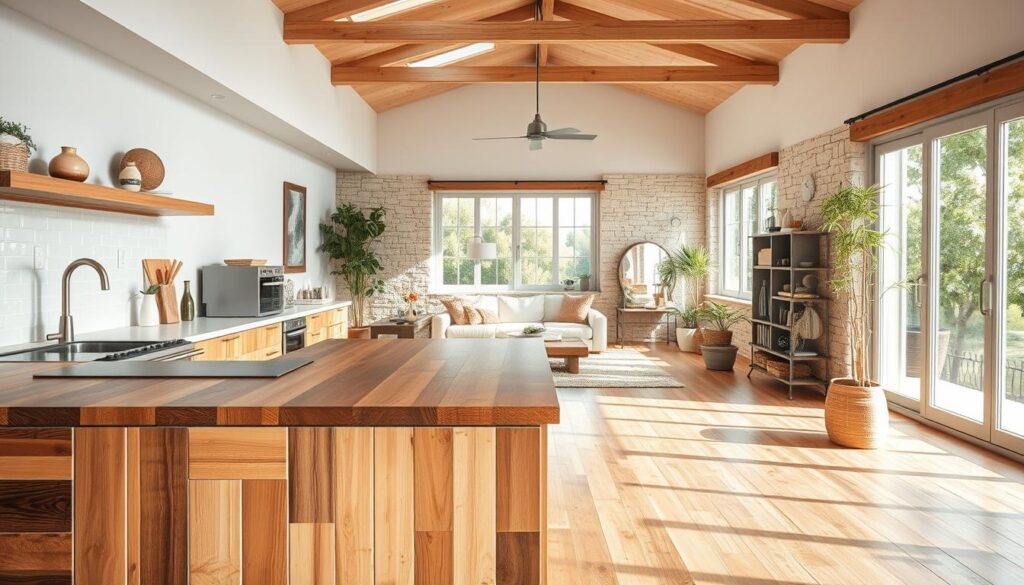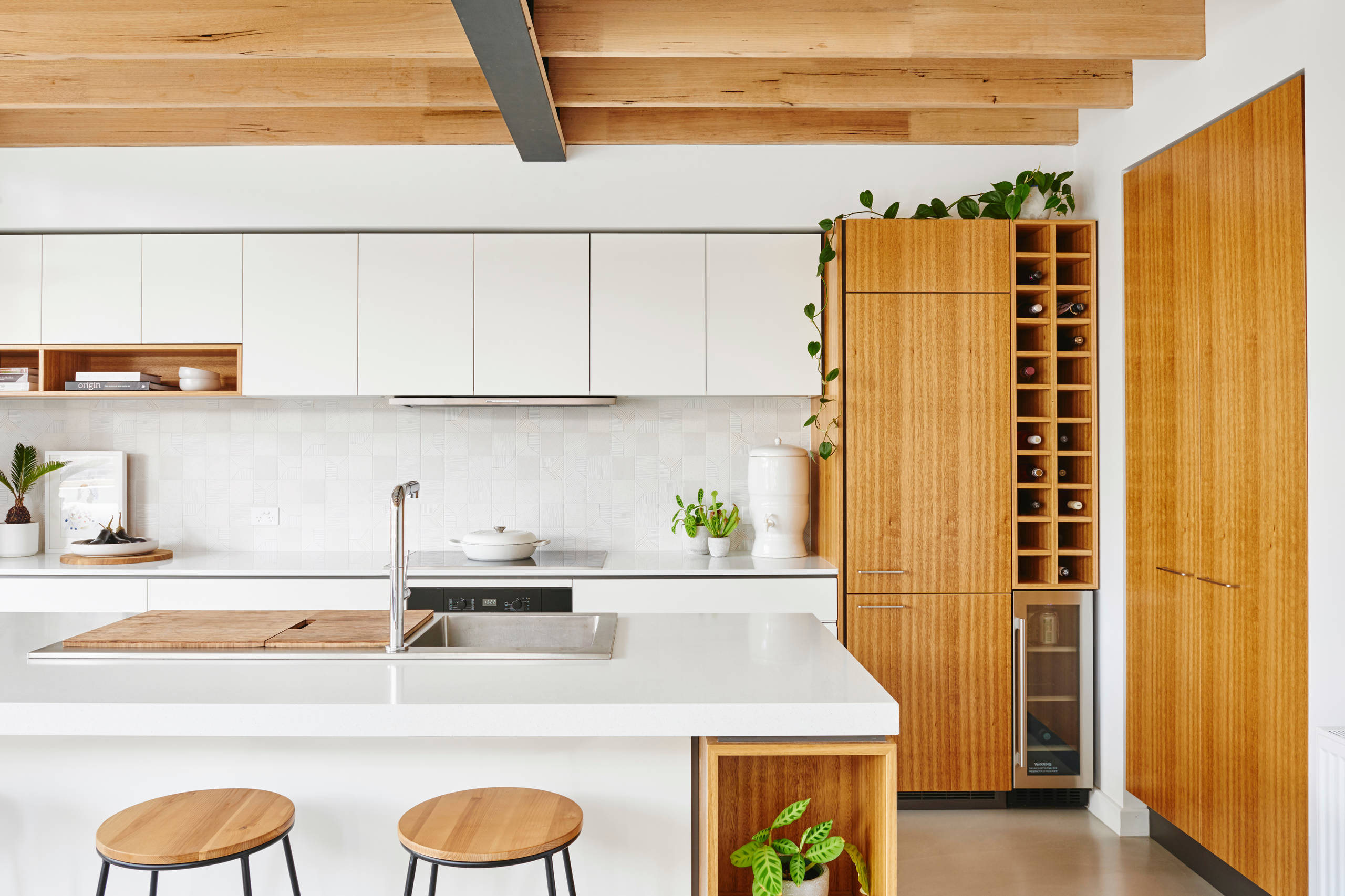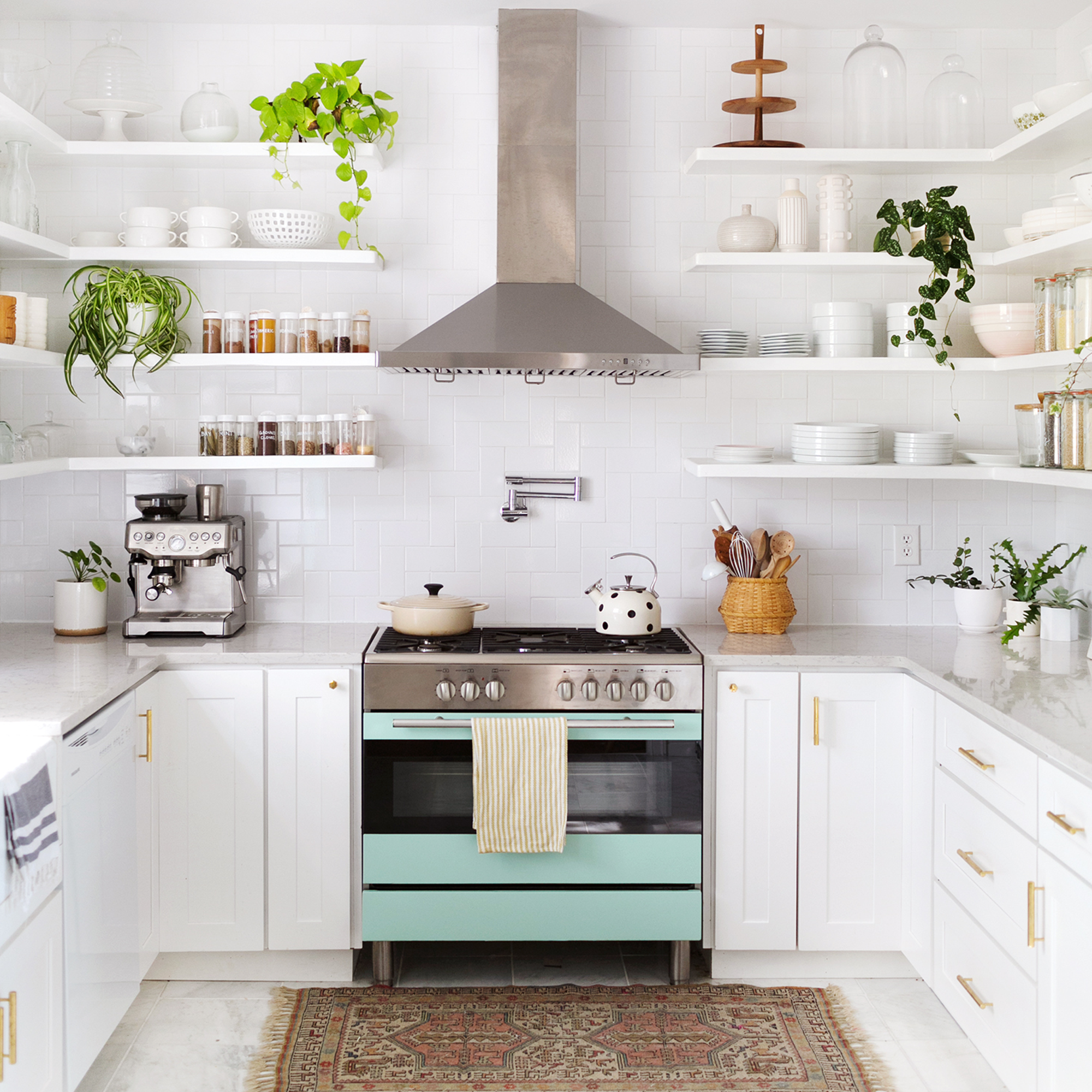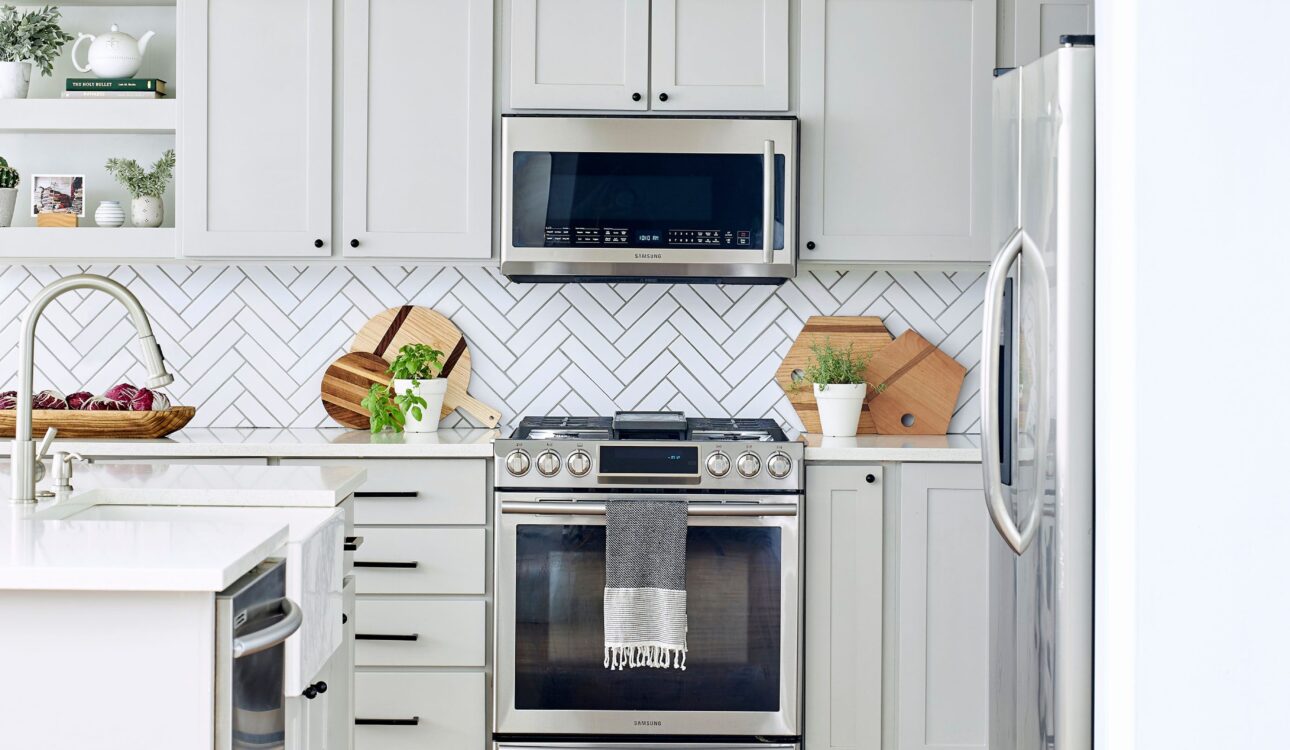Have you ever stood in the middle of a renovation project, torn between wanting a space that feels like home and one that respects the planet? I have. Years ago, while updating my own house, I realized how overwhelming it can be to balance style with sustainability. That’s when I discovered a truth: Sustainable Building Materials and Modern Kitchen Design: Eco-Friendly Options for Your Home don’t mean sacrificing beauty—they enhance it, offering a smarter, more meaningful way to upgrade your space.
Today’s homeowners want spaces that reflect their values. Whether you’re remodeling a cooking area or reimagining your entire house, sustainable materials offer durability and elegance. Think reclaimed wood countertops or recycled glass tiles—they’re not just kind to the Earth. They add character and warmth to even the most streamlined layouts.
This guide will walk you through options that blend environmental responsibility with timeless appeal. You’ll learn how to create functional, open spaces using resources that minimize waste. From bamboo flooring to low-VOC paints, every choice matters. And yes—you can achieve that crisp, clutter-free look while still prioritizing the planet.
Key Takeaways
- Sustainable materials now rival traditional options in style and durability.
- Eco-friendly choices enhance both aesthetics and home value.
- Modern spaces thrive on simplicity—open layouts pair perfectly with green solutions.
- Every renovation decision impacts energy efficiency and indoor air quality.
- Professional guidance ensures seamless integration of form and function.
Ready to transform your space? For personalized advice on merging sustainability with sophistication, reach out to Fine Line Kitchens Inc. at +1 (703)-261-6151 or visit their contact page. Let’s build homes that look good and do good.
Introduction to Sustainable Building Materials
Every renovation choice we make leaves a footprint—what if yours could heal the planet? Sustainable building materials are reshaping how homeowners approach upgrades, blending environmental care with lasting quality. These resources prioritize responsible sourcing, energy-efficient production, and durability that outlasts conventional options.

Defining Eco-Friendly Renovation
Eco-friendly renovation means selecting items that protect both your family and the Earth. Low-VOC paints, recycled metal fixtures, and rapidly renewable bamboo reduce toxins while conserving resources. These choices create healthier indoor air—a critical factor for spaces where families gather.
Contrary to myths, sustainable materials offer endless style flexibility. Reclaimed wood beams add rustic charm, while recycled glass countertops provide sleek sophistication. Durability shines here too: cork flooring naturally resists moisture, and recycled steel roofing withstands extreme weather.
Why Sustainability Matters in Home Design
Homeowners now recognize that green upgrades boost property value and slash utility bills. Energy-efficient insulation cuts heating costs by up to 20%, while solar-ready roofs future-proof your investment. Even small changes—like LED lighting—make measurable impacts.
Beyond economics, sustainable materials foster personal well-being. Natural linoleum avoids synthetic chemicals, and wool carpeting regulates humidity. These thoughtful selections create spaces that feel as good as they look.
Ready to explore eco-conscious ideas? Fine Line Kitchens Inc. offers expert guidance through every phase. Call +1 (703)-261-6151 to discuss solutions tailored to your home’s needs.
Modern Kitchen Design Trends
Gone are the days of isolated cooking spaces; today’s homes thrive on connection. The latest trends focus on creating fluid environments where families cook, dine, and relax in harmony. Central to this shift are designs that prioritize both social interaction and visual balance.

Embracing Open-Space Living
Walls between rooms continue to disappear as homeowners merge their cooking areas with dining and living zones. This approach transforms the heart of the home into a versatile hub. Islands with tiered seating—like a breakfast bar paired with stool-height counters—let people chop vegetables while helping kids with homework.
Large windows flood these spaces with sunlight, enhancing the airy feel. Clean-lined cabinetry and stone surfaces maintain simplicity while offering durability. Natural materials like walnut shelves or marble backsplashes add warmth without clutter.
Neutral Palettes with Bold Accents
Soft whites and earthy grays form the backbone of today’s color schemes. These tones create calm backgrounds that adapt to seasonal decor changes. Strategic accents—like emerald-green barstools or a cobalt-blue mixer—inject personality without overwhelming.
Designers often use textured elements to add depth. Think matte-finish tiles alongside glossy countertops or woven light fixtures above smooth concrete floors. This balance keeps rooms feeling fresh yet inviting.
| Feature | Traditional Approach | Current Trend |
|---|---|---|
| Layout | Separated rooms | Connected living zones |
| Color Scheme | Matching cabinets/appliances | Neutral base + vibrant accents |
| Lighting | Overhead fixtures only | Layered natural + task lighting |
Eco-Friendly Kitchen Material Options
The heart of your home deserves materials that care for the Earth. Today’s eco-conscious choices for cabinets, surfaces, and finishes prove sustainability and style coexist seamlessly. Let’s explore options that reduce environmental impact while elevating your space’s functionality.

Sustainable Cabinetry and Countertops
Frameless cabinetry made from reclaimed wood or bamboo offers sleek lines and maximized storage. These materials avoid deforestation while providing lasting durability. Low-VOC finishes ensure healthier air quality, a critical factor for families.
For countertops, recycled glass blends shimmering aesthetics with diverted landfill waste. Sustainably quarried stone like quartz requires less energy to produce than traditional options. Brands with FSC certification guarantee responsible sourcing from start to finish.
Recycled Stone and Other Natural Finishes
Composite materials made from post-consumer content mimic marble’s elegance without the ecological cost. Cork backsplashes add warmth and natural sound absorption. Hemp-based composites work beautifully for sinks and decorative panels, resisting moisture effortlessly.
Prioritize GREENGUARD-certified products to ensure low emissions. Pull-out organizers in cabinets keep essentials accessible, maintaining clutter-free zones. These choices prove eco-friendly storage solutions can be both practical and visually harmonious.
Ready to make intentional selections? Fine Line Kitchens Inc. specializes in materials that balance ethics with elegance. Call +1 (703)-261-6151 to discuss your project’s unique needs.
Incorporating Open Spaces and Natural Light in Your Home
Sunlight streaming through windows transforms more than just your walls—it reshapes how you experience your living areas. Strategic window placement paired with thoughtful layouts creates rooms that breathe, connecting you to nature while boosting daily comfort.
Designing for Maximum Functionality
Open floor plans erase barriers between cooking, dining, and relaxation zones. This flow encourages conversation while making small spaces feel expansive. Large glass doors or skylights amplify brightness without sacrificing energy efficiency—double-paned options keep heat transfer in check.
Light-colored walls and glossy surfaces bounce sunlight deeper into your home. A well-placed mirror near a window can brighten dim corners instantly. For privacy without blocking light, consider frosted glass partitions or sheer window treatments.
Multi-functional furniture keeps open layouts clutter-free. A kitchen island with built-in storage doubles as a breakfast nook, while movable shelving adapts to changing needs. Layered lighting—recessed LEDs paired with dimmable pendants—ensures warmth after sunset.
Studies show spaces flooded with natural light improve focus and reduce stress. Morning sunlight regulates sleep cycles, while airy layouts promote physical movement. Your home becomes both a sanctuary and a catalyst for healthier living.
Budget-Friendly Updates for Your Modern Kitchen Design
Renovating your cooking space doesn’t have to drain your savings—smart updates can deliver high-end looks for less. Focus on strategic changes that maximize visual impact while minimizing costs. A fresh coat of paint or updated fixtures often creates the transformation homeowners crave.

Simple Cabinet Transformations with Matte Finishes
Painting existing cabinets offers one of the most dramatic upgrades. Matte finishes hide minor dings while creating a sleek, contemporary feel. Neutral tones like warm gray or soft white provide timeless appeal, allowing bold accents elsewhere to shine.
Updating hardware delivers instant polish without new drilling. Choose brushed nickel pulls or matte-black knobs that align with existing hole patterns. This swap takes an afternoon but elevates the entire room’s aesthetic.
| Update | Cost Range | Visual Impact |
|---|---|---|
| Cabinet Painting | $200-$800 | High |
| Hardware Replacement | $50-$300 | Medium-High |
| LED Lighting Installation | $100-$400 | Medium |
Pair these changes with cohesive color ideas. Light walls make spaces feel airy, while navy or sage lower cabinets add depth. Under-cabinet LED strips brighten workspaces and highlight clean lines.
For personalized ways to refresh your kitchen design, consult Fine Line Kitchens Inc. at +1 (703)-261-6151. Their expertise turns budget-conscious ideas into reality without compromising style.
Eco-Friendly Lighting and Backsplash Inspirations
Light shapes more than visibility—it defines atmosphere. Thoughtful illumination paired with striking wall treatments transforms functional areas into artistic statements. These elements work together to balance environmental responsibility with visual impact.
Illuminating Style with Purpose
LED fixtures cut energy use by 75% compared to traditional bulbs. Solar-powered accent lights add drama to decor while harnessing renewable power. For bold ideas, try pendant clusters made from recycled metals or FSC-certified wood.
Under-cabinet strips provide task lighting without glare. Pair them with dimmable smart systems that adjust brightness for chopping veggies or hosting dinners. This flexibility reduces electricity bills while enhancing ambiance.
Wall Solutions That Tell Stories
Recycled glass tiles mimic natural minerals but use 40% post-consumer materials. Extend countertops up the wall for seamless maintenance and reduced waste. This approach creates clean lines that designers love in light-filled spaces like Lumen Lodge.
Cork backsplashes bring warmth and sound absorption. Bamboo panels offer water resistance with rapid renewability. These choices prove sustainable decor can be both practical and conversation-starting.
Designing with Sustainable Finishes and Hardware
The smallest details often make the biggest statement. Selecting hardware that aligns with eco-conscious values proves style and sustainability aren’t mutually exclusive—they’re collaborators in crafting intentional spaces.
Choosing Hardware with an Eco-Conscious Edge
Recycled aluminum and reclaimed brass offer sleek profiles while diverting waste from landfills. These materials maintain crisp, angular lines that complement minimalist design principles. Brushed steel or matte black finishes add visual interest without harsh chemical treatments.
Durability matters just as much as aesthetics. Powder-coated options resist fingerprints and corrosion, reducing replacement needs. For unique texture, consider handles with bamboo inlays or cork accents—rapidly renewable resources that warm up metallic surfaces.
| Feature | Traditional Hardware | Sustainable Option | Environmental Benefit |
|---|---|---|---|
| Material Source | Virgin Metals | Recycled Aluminum | Reduces mining waste |
| Finish Process | High VOC Coatings | Low-VOC Powder Coating | Improves indoor air quality |
| Longevity | Prone to Corrosion | Stainless Steel with UV Protection | Resists wear, fewer replacements |
Mixing finishes like satin chrome and oil-rubbed bronze creates depth while keeping a cohesive look. Opt for elongated pulls on drawers and compact knobs on cabinets—this balance enhances functionality without clutter.
Integrating Sustainable Design into Every Room
What if every corner of your home could reflect your commitment to the planet? Sustainable principles aren’t confined to one area—they thrive when applied holistically. Thoughtful material choices and intentional layouts create harmony between aesthetics and environmental care across all living zones.
Multi-Functional Spaces for Everyday Living
Rooms that serve multiple purposes reduce resource use while enhancing daily life. A dining table with built-in storage doubles as a homework station. Fold-down desks in bedrooms maximize small spaces without compromising style.
Open shelving in living areas displays plants or art while keeping essentials accessible. Choose furniture made from reclaimed wood or recycled metals. These pieces add character while supporting circular economies.
Accent Pieces and Decorative Accessories
Decorative accessories offer subtle yet impactful ways to embrace sustainability. Handwoven baskets from renewable grasses organize throws or magazines. Wall mirrors framed in recycled aluminum amplify natural light and visual space.
Incorporate art created with low-impact dyes or repurposed materials. A statement ceiling fixture made from salvaged glass becomes a conversation starter. Every choice—from table linens to island stools—tells a story of mindful living.
Ready to weave eco-conscious details throughout your space? Fine Line Kitchens Inc. offers whole-home solutions that balance beauty and responsibility. Call +1 (703)-261-6151 to begin your journey toward intentional decor.
FAQ
How can I update cabinets without replacing them?
Try matte-finish paint in muted tones like sage or slate gray. Swap dated hardware for brass or blackened steel pulls from brands like Rejuvenation for an instant refresh. Lining interiors with recycled paper or cork adds subtle sustainability.
What lighting works well in open-concept spaces?
Pendant lights with organic shapes or fixtures made from recycled metals create focal points. Layer ambient LED strips under shelves and task lighting above islands to balance functionality and style.
Are there sustainable options for backsplashes?
Yes! Consider tiles made from recycled ceramic, glass, or even repurposed denim. Companies like Fireclay Tile offer low-VOC glazes and materials that reduce waste while delivering bold patterns or earthy tones.
Can small kitchens still feel spacious and eco-conscious?
Absolutely. Opt for light-reflective finishes like low-VOC white paint, install floating shelves from salvaged wood, and use energy-efficient under-cabinet lighting. Multi-functional islands with reclaimed stone tops maximize utility.
How do I choose eco-friendly hardware?
Look for pulls and knobs crafted from recycled brass, aluminum, or sustainably harvested materials. Brands like Emtek and Schoolhouse prioritize ethical sourcing and minimal packaging without compromising on sleek, modern aesthetics.
What accents elevate a neutral palette sustainably?
Add texture with jute rugs, linen curtains, or handcrafted pottery. Vintage decor or upcycled art pieces introduce character while reducing the need for new resources. Plants like succulents or herbs in recycled pots bring life indoors.






